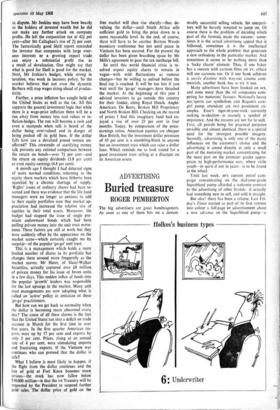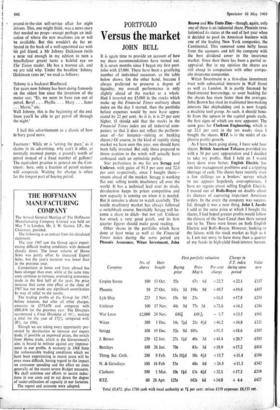Buried treasure
ADVERTISING ROGER PEMBERTON
The big advertisers are great bandwagoners. As soon as one of them hits on a demon- strably successful selling vehicle, his competi- tors will be fiercely tempted to jump on. Of course there is the problem of deciding which part of the formula made the success: some- times it is the actual advertising appeal that is followed, sometimes it is the intellectual approach to the whole problem that generates a new orthodoxy in the particular market. And sometimes it seems to be nothing more than a 'lucky charm' element. Thus, if one baker has a success with cartoon films on iv, others will use cartoons too. Or if one bank achieves a succes destime with way-out cinema com- mercials, another bank has to try it too.
Many advertisers have been hooked on sex, and none more than the oil companies com- peting for motorists' favours. National's heavy sex/sports car symbolism and Regent's cow- girl pump attendant are two prominent ex- amples. Esso's tiger-in-your-tank—currently seeking re-election—is scarcely a symbol of impotence. And the reasons are not far to seek. First, all petrols being for practical purposes invisible and almost identical, there is a special need for the strongest possible imagery. Secondly, advertising is only one of the many influences on the customer's choice and the advertising is aimed directly at only a small part of the motoring market, concentrating for the most part on the premium grades appro- priate to high-performance cars, where virile youth—in spirit if not in years—is to be found at the wheel.
Until last week, BP's current petrol cam- paign concentrating on the dial-your-grade Superblend pump afforded a welcome contrast to the advertising of other brands: it actually had something new to sell, and sold it straight.
But alas! there has been a relapse. Last Fri- day's Times carried as part of its first venture into colour a full-page 13P advertisement about a new advance on the Superblend pump—a pound-in-the-slot self-service affair for night drivers. This, one might think, was a news story that needed no props-except perhaps an indi- cation of where the new machines are or will be available. But this wouldn't do for BP. Seated in the back of a well-appointed car with his girl friend, a Mr Johnny Dickinson (with a nose red enough in my edition to turn a breathalyser green) turns a baleful eye on The Times reader. He has a morose air, and we are told why. Under the headline 'Johnny Dickinson rates BP,' we read as follows : 'Johnny is a backseat Bluebeard.
For years now Johnny has been doing famously on the oldest line since the invention of the motor car; "Er, we seem to have run out of petrol, Beryl . . . Phyllis . . . Mary. . . Janet . Mavis," etc.
Well Johnny, this is the beginning of the end. Soon -you'll be able to get petrol all through the night.'
I hail this advertisement as a classic of how to bury good news.
Footnote : While BP is 'setting the pace,' as it claims in its advertising, why can't it offer, at normally manned pumps, a pound's worth of petrol instead of a fixed number of gallons? The equivalent practice is general on the Con- tinent: here, only a fraction of petrol stations will cooperate. Waiting for change is often far the longest part of buying petrol.







































 Previous page
Previous page